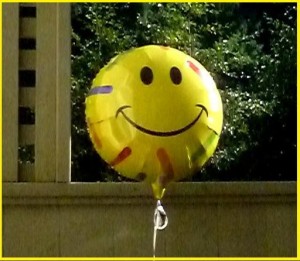The Case for Office and Home Balloons

No, I don’t know anybody in the balloon business.
That disclaimer in place, I want to convince you that having just one balloon in your office and one at home is a very good idea—with positive consequences for employee morale, client and customer receptivity, employer mood and home atmosphere.
The personal and theoretical reasons that can be cited include that we seem to be neurologically hard-wired to respond to that kind of smiley balloon very positively. I know I am and that I do.
Our mood is buoyed, our outlook is subtly shifted toward the cheerful, optimistic pole and, despite our full awareness of the fact that we are looking at an inflated, imprinted plastic bag, we, like babies or bird nestlings terrified of overhead cardboard hawk silhouettes, are that easy to fool [but, in the balloon case and in Thanksgiving Day cartoon-blimp festooned parades, in a very nice way].
The original designer of the yellow smiley face [not Tom Hanks, a.k.a. “Forrest Gump”, humorously and fictitiously credited with the achievement in that movie], tapped into our primal receptivity to smiles— living or not.
The real-world history of that irrepressible smile, which dates back to as early as 1948, in with a huge spike in the 60s and 70s, notes that Harvey Ball a commercial artist tasked, in 1967, with creating the design for an insurance company, received only $45 for it on a work-for-hire basis.]
This smiley balloon suggestion is a serious recommendation, which I confirm by citing the fact that the photo shown was taken at my patio door, which virtually never has traffic—smiling or otherwise—passing it, save for my phantom-couple neighbors I generally only hear as they start up or shut down their cars and shuffle to or from their door.
I know it’s only plastic and string, and that it is literally an airhead [actually, heliumhead], but that gently bobbing ,always smiling face is magnetically attractive, indeed, irresistible, as gabillions of sold smiley stickers, T-shirts, mugs, towels, napkins and—yes—smiley-face, otherwise mood-breaking condoms amply and indisputably attest.
Securing a smiley balloon that also bobs and spins makes the illusion of life-likeness even stronger and more irresistible. You can try a smiley mug or button, but it won’t really compare.
Having “Smiley” at my door, benignly and approvingly smiling, nodding, spinning and swaying at me as I write this, reassures me that I’m on the right/write track and that everything is fine. So, if it works for me, works for the hundreds of millions of smiley-merchandise buyers and recipients and works for birds and babies, it should work for you.
Balloon Smile Psychology
The psychologist-pragmatic philosopher William James is noted for having said, among other things, that “a man doesn’t cry because he is sad; he is sad because he cries”— this is a crisp, oft-quoted statement of the James-Lange hypothesis predicated on the idea that emotions are effects of physiological states, not their causes.
Hence, given the innate human tendency to mirror a smile, even if only partially, as a so-called incomplete “intention movement” [like jiggling your foot when you wish you could leave or crouching before leaping], that physiological state is, on the James-Lange theory, likely to induce a corresponding pleasant emotional state.
Speaking of cause and effect, since the balloon smiley face cannot be the effect of our own smiles, it must be the cause, when the balloon and we find ourselves smiling at each other.
Less playfully, I also want to suggest, broadening the James-Lange hypothesis, that the balloon either triggers the kinds of antecedent physiological states, namely, smiles or partial smiles, that cause the happy feelings, or triggers the emotions directly [even though Smiley’s is a manufactured smile].
Balloon Smile Anthropology
If 19th-century speculations about emotion don’t seem compelling, let’s go back much farther in human history—for a look at primitive animism and modern anthropological speculation about it: It seems that our most primitive hominid ancestors, like your average cat, couldn’t help believing that almost everything is alive—especially everything that moves. That’s animism.
They also apparently couldn’t help believing that any “simulacrum” [replica, depiction, facsimile, etc.] of anything living is itself living—hence the obsession with, worship of and/or magical use of statuary, dolls and cave paintings, e.g., of bison and wooly mammoths [“Paint them and they will come!”].
Is it not, therefore, unsurprising that we are so much like them in this respect that we will respond to a smile simulacrum—especially one that moves— as though it were the real, living thing?
Seated in your office, you are, architecturally and socially speaking, very distant from some Neanderthal or Homo habilis cave; but do you really think your genes and the psychological susceptibilities they code for have been equally radically redesigned? My guess is that you and I remain primitive pushovers for a smile, real or not, including real-human fake-smiles, e.g., at a fast-food service counter or used car lot.
Better Than “Have a Nice Day!”
So if you are going to fall for fake human smiles [as opposed to authentic “Duchenne” smiles—named after the researcher who identified their physiology], why fight the charms of a fake balloon smile? After all, at least the balloon will keep on smiling at you after you’ve forked over your cash for it.
Besides, mine, at $1.25, cost less than a Big Mac and is lasting a whole lot longer.

